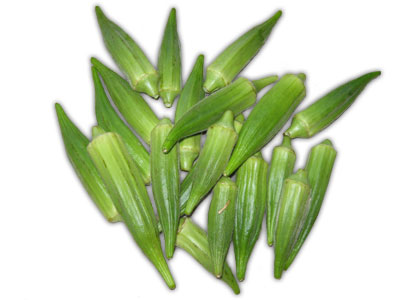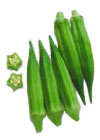|
Okra
(Hibiscus Esculentus)
Description:
 Okra (Hibiscus Esculentus) is a flowering plant in the mallow family Malvaceae, originating somewhere near present-day Ethiopia. The word okra is of African origin and means "lady's fingers" in Igbo, a language spoken in what is now known as Nigeria. Okra is grown throughout the tropical and warm temperate regions of the world for its fibrous pods full of round, white seeds, which, when picked young, are eaten as a vegetable. Okra is among the most heat- and drought-tolerant vegetables in the world; once established, it can survive severe drought conditions. Okra (Hibiscus Esculentus) is a flowering plant in the mallow family Malvaceae, originating somewhere near present-day Ethiopia. The word okra is of African origin and means "lady's fingers" in Igbo, a language spoken in what is now known as Nigeria. Okra is grown throughout the tropical and warm temperate regions of the world for its fibrous pods full of round, white seeds, which, when picked young, are eaten as a vegetable. Okra is among the most heat- and drought-tolerant vegetables in the world; once established, it can survive severe drought conditions.
Uses:
It is one of the most popular vegetables in late 20th century Japanese cuisine. In Israel, Jordan, Greece and other parts of the eastern Mediterranean, okra, known in Arabic and in Greek as bamia, is widely used in a thick stew made with vegetables and meat. It is also common in Indian cooking where it is either sautéed or added to gravy based preparations. When buying fresh okra, look for young pods free of bruises, tender but not soft, and no more than 4 inches long. It may be stored in the refrigerator in a paper bag or wrapped in a paper towel in a perforated plastic bag for 2 to 3 days, or it may be frozen for up to 12 months after blanching whole for 2 minutes. Cooked okra can be stored (tightly covered) in the refrigerator for 3 to 4 days. Okra can be served raw, marinated in salads or cooked on its own, and goes well with tomatoes, onions, corn, peppers, and eggplant. Whole, fresh okra pods also make excellent pickles. Its subtle flavor can be compared to eggplant, though the texture is somewhat unusual. Many people prefer breaded and fried okra, because the slippery substance is less pronounced.

Production and Packing:
Climson spineless in the main variety grown in Cyprus for export purposes. It is sown in early spring and harvest begins in June through to October, reaching peak volumes in early August. The product arrives soon after harvest in the pack house and pre-cooled down to 80C before packaging in carton boxes of 5kgs takes place. The product is air-freighted to destination markets within 24hrs from harvest.
|